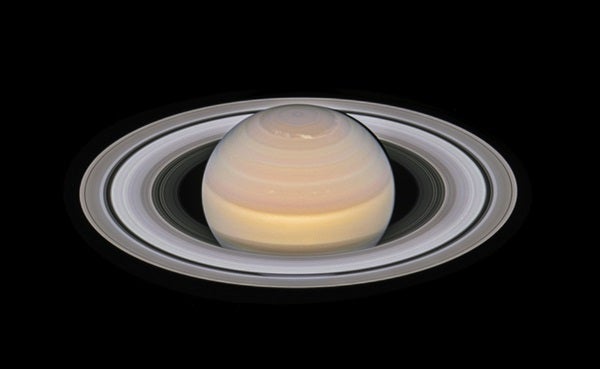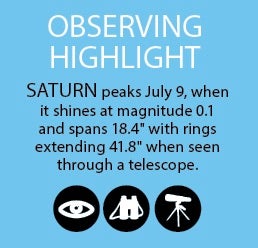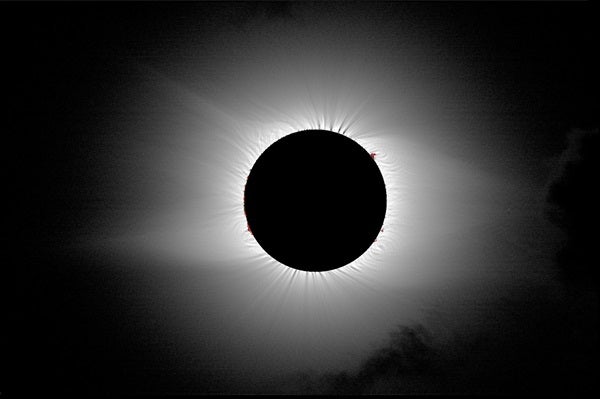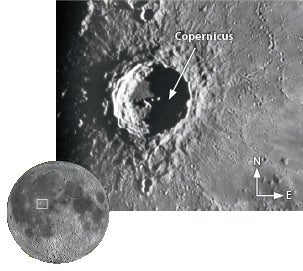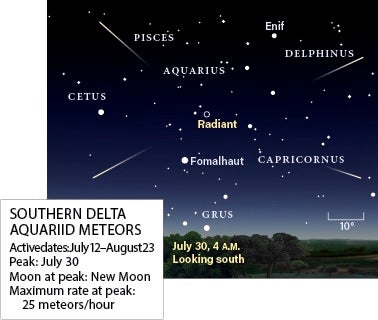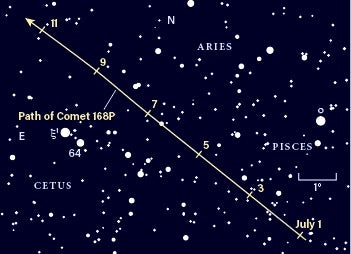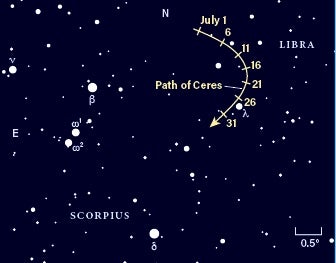Let’s start our celestial tour with Mercury and Mars, which we can see only in early July. The two planets glow faintly in the west-northwest shortly after sundown. Your best opportunity to find them comes July 3, when a waxing crescent Moon points the way.
The one-day-old Moon then stands 5° above the horizon 30 minutes after sunset. Once you locate it, use binoculars to spy magnitude 1.8 Mars 3° to the upper left. Mercury glows a bit brighter, at magnitude 1.4, some 4° to the Red Planet’s left.
In between the brilliant flashes and explosions of your local July 4 fireworks, look to the west for a noticeably fatter crescent Moon, now some 15° high a half-hour after sunset. The two planets lie about 10° to our satellite’s lower right.
You won’t have to search as hard to find Jupiter. The giant planet stands clear of the southeastern horizon after sunset and climbs nearly 30° high in the south well before midnight. It shines at magnitude –2.5 against the faint backdrop of southern Ophiuchus the Serpent-bearer.
Any telescope shows Jupiter’s disk. In mid-July, the world spans 44.4″ across its equator and 41.6″ through its poles. The 6 percent discrepancy, caused by a combination of Jupiter’s gaseous nature and its less than 10-hour rotation period, becomes obvious once you know to look for it.
Jupiter’s four bright moons — Io, Europa, Ganymede, and Callisto, in order of increasing distance — circle the gas giant in periods ranging from a couple of days to a couple of weeks. The three inner satellites cross in front of and pass behind the planet once each orbit. Many observers consider these events the highlight of a Jupiter viewing session.
Let’s take a look at a few of July’s best. Io transits Jupiter’s disk during the evening hours July 4, 11, 18, and 27. On the 4th, the transit begins at 10:02 p.m. EDT while the moon’s shadow follows 34 minutes later. Both appear against the planet’s North Equatorial Belt. The July 11 transit starts at 11:48 p.m. EDT with the shadow trailing 42 minutes behind. The longer gap arises from a shift in the relative positions of Jupiter, the Sun, and Earth.
Io circles Jupiter quickly, and the following evening you can see the moon as it comes around the planet’s far side. At 11:51 p.m. EDT on the 12th, Io emerges from Jupiter’s shadow some 14″ off the eastern limb and adjacent to the South Equatorial Belt.
Jupiter’s darker and largest moon, Ganymede, crosses the gas giant’s north polar region the evening of July 24. The transit begins before sundown, but viewers in the eastern half of North America can watch it wrap up at 9:58 p.m. EDT. The moon’s shadow first touches the jovian disk at 11:26 p.m. EDT and takes 2 hours 27 minutes to finish its trek. Ganymede offers an encore performance on the 31st.
Lovely Saturn lies among the background stars of Sagittarius the Archer, just south of that constellation’s Teaspoon asterism. It moves westward relative to this backdrop throughout July, passing 1.1° south of magnitude 2.9 Pi (π) Sagittarii on the 20th and ending the month 0.7° southeast of magnitude 3.8 Omicron (ο) Sgr.
The ringed planet reaches opposition and peak visibility July 9, when it lies opposite the Sun in our sky and thus stays out all night. Opposition also brings the world closest to Earth, so it shines at its brightest for the year, magnitude 0.1. As an outer planet, however, Saturn changes slowly, and it remains within a few hundredths of this magnitude all month.
For viewers at mid-northern latitudes, Saturn reaches a peak altitude of nearly 30° at 1:30 a.m. local daylight time July 1 and about 30 minutes earlier each week thereafter. Skywatchers farther north will find Saturn lower in the sky, and those farther south will see it climb higher.
Saturn provides observers with more moons than Jupiter. Any telescope reveals 8th-magnitude Titan, which circles the planet once every 16 days. When the giant satellite lies north or south of Saturn, it appears 1.3′ away. At greatest eastern or western elongation, Titan lies 3.1′ from the planet.
Outer Iapetus glows at 10th magnitude in the days around its July 15 greatest western elongation. Your best chance to see it comes on opposition night when it lines up with Titan. The outer moon then lies 8.4′ west of Saturn, some 2.7 times farther away than Titan.
The two outer planets appear best during the morning hours. Neptune rises around midnight local daylight time July 1 and by 10 p.m. on the 31st. It lies in Aquarius, just east of 4th-magnitude Phi (ϕ) Aquarii. The planet’s westward motion against this backdrop reduces the gap between it and Phi from 1.3° to 0.9° during July. Magnitude 7.8 Neptune shows up easily through binoculars; a telescope at high magnification shows the planet’s 2.3″-diameter disk and blue-gray color.
Uranus stands 20° above the eastern horizon as twilight begins July 1 and more than doubles that altitude by month’s end. It resides in southern Aries, 10° south and slightly east of 2nd-magnitude Hamal (Alpha [α] Arietis), the Ram’s brightest star. The magnitude 5.8 planet stands out surprisingly well through binoculars in a sparse region 2.3° south of the magnitude 5.7 star 19 Ari. When viewed through a telescope, Uranus shows a distinctive blue-green color on a disk that spans 3.5″.
July 1 provides your best chance to see Venus before it disappears in the Sun’s glare. Use the waning crescent Moon as a guide. It appears 5° high in the east-northeast 30 minutes before sunrise, and Venus lies one binocular field to the lower left. Despite gleaming at magnitude –3.9, the planet barely shows up against the brightening sky. You might be able to track Venus for a few more days, but it drops out of view by the end of July’s first week.
A total solar eclipse occurs July 2 along a narrow track that crosses the South Pacific, Chile, and Argentina. The Moon’s umbral shadow first touches South America on the Chilean coast near La Serena and completes its trek as the Sun sets just south of Buenos Aires.
Rising Moon: A crater worthy of an eminent astronomer
Terraced walls, complex central peaks, a rough ejecta blanket, and an expansive ray system at Full Moon — it’s no surprise that lunar observers visit the crater Copernicus again and again. The Sun first rises over this crater’s tall, modestly sharp rim July 11, two nights after First Quarter phase.
The low Sun angle on the 11th casts long shadows, accentuating the visibility of peaks and bumps as well as holes and mild depressions. Notice the jagged black teeth the eastern rim projects onto Copernicus’ floor. A textured apron surrounds the entire crater. It originated when surface material got splattered outward in all directions in the immediate aftermath of the impact that created Copernicus. Lunar geologists call it an ejecta blanket.
The terraced walls are a delight to see at high power. To imagine how they formed, dig a hole in a wet sandy beach. Within seconds, the steep walls collapse inward to form giant staircases down to the floor. Sharp-eyed observers may notice that Copernicus’ terraces tilt down to the outside because the higher inner edge casts a shadow toward the rim. The eastern terraces show up best on the 11th. In case you get clouded out, the sequence almost repeats the evening of August 9, but with an even lower Sun angle than the image shown here.
For a few days on either side of the July 16 Full Moon, the nearly overhead Sun beats down on the 60-mile-wide crater. Thread in a filter to reduce the glare, pump up the power, and take in the scenery. The rough terrain and differences in elevation and texture have completely disappeared, replaced by a land of light rays and darker mare material showing through from underneath. These brightness variations help astronomers piece together the history of the lunar surface. The impacting asteroid may have landed in a dark lava field, but the blast excavated down to lighter-hued rocks and hurled them outward to create the superb ray system.
Metor Watch: The year’s longest-running show
THE southern strand of the Delta Aquariid meteor stream encounters Earth during much of July and August, but reaches a broad peak from July 28–30. And with New Moon arriving on the 31st, viewing conditions this year should be close to perfect. Under a dark sky with the radiant — the point in Aquarius from which the meteors appear to emanate — overhead, observers could see up to 25 meteors per hour.
Unfortunately for Northern Hemisphere skygazers, the radiant never passes overhead. From mid-northern latitudes, the radiant peaks at an altitude of 35° between 3 and 4 a.m. local daylight time. This cuts the observed number of meteors roughly in half, with observers in the southern United States seeing a few more and those in Canada a few less.
Comet Search: Take a dip in the celestial sea
After a few months’ lull, things are looking up for comet observers. It appears we’ll see at least one comet glowing at 10th magnitude or brighter every month starting this autumn and running through the end of next year.
You can get a head start before dawn breaks these short summer nights. Comet 168P/Hergenrother swims the waters near the border between Pisces the Fish and Cetus the Whale before emerging onto the dry land of Aries the Ram during July’s second week.
Hergenrother loops through the inner solar system every 6.8 years. On its last time through in 2012, the dirty snowball experienced an outburst and brightened past 10th magnitude. If we aren’t lucky again, the comet may reach only 12th magnitude in July and be a difficult fuzzball. The best observing window comes during the month’s first two weeks when the Moon stays out of the morning sky.
As its high number attests, 168P/Hergenrother is a relatively recent find. American astronomer Carl Hergenrother first spotted it in 1998 during a survey to discover asteroids.
Locating Asteroids: A dwarf planet swings through Libra
The dwarf planet Ceres climbs highest in the south as darkness falls, making a tempting target during the early evening hours. Glowing at 8th magnitude, it’s easy to find through binoculars or a small telescope among the bright stars near the border between Scorpius the Scorpion and Libra the Scales.
Ceres lies about 15° west of Jupiter all month, but it’s simpler to locate by hopping from the lovely 2nd-magnitude double star Beta (β) Scorpii. The dwarf planet lies within 3° of Beta all month. It ventures even closer to magnitude 5.0 Lambda (λ) Librae during July’s final week. Only 8′ separate the two at their closest the evening of the 27th.
To identify Ceres from the background stars, make a sketch at the eyepiece that includes three or four stars in addition to the dot you think is the dwarf planet. Return to the same field a night or two later and see which object shifted position. The “star” that moved is Ceres. Fortunately, the Milky Way dust lanes that thread through this region help suppress the number of faint background stars that could confuse matters.
Ceres is the undisputed king of the asteroid belt. Its substantial size, nearly 600 miles across, and nearly spherical shape helped persuade astronomers to raise its status from asteroid to dwarf planet.

